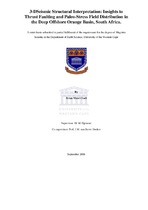3-D Seismic structural interpretation : insights to thrust faulting and paleo-stress field distribution in the deep offshore Orange Basin, South Africa
Abstract
The Orange Basin provides exceptional 3-D structures of folds and faults generated during soft-sediment slumping and deformation which is progressive in nature. 3-D seismic and structural evaluation techniques have been used to understand the geometric architecture of the gravity collapse structures. The location of the seismic surveyed area is approximately 370 km northwest of the Port of Saldanha. The interpretation of gravitational tectonics indicate significant amount of deformation that is not accounted for in the imaged thrust belt structure. The Study area covers 8200 square kilometre (km²) of the total 130 000 km² area of the Orange Basin offshore South Africa. The south parts of the Study area are largely featureless towards the shelf area. The north has chaotic seismic facies as the result of an increase in thrust faults in seismic facies 2. Episodic gravitational collapse system of the Orange Basin margin characterizes the late Cretaceous post-rift evolution. This Study area shows that implications of stress field and thrust faulting to the thickness change by gravity collapse systems are not only the result of geological processes such as rapid sedimentation, margin uplift and subsidence, but also could have occurred as the result of the possible meteorite impact. These processes caused gravitational potential energy contrast and created gravity collapse features that are observed between 3000-4500ms TWT intervals in the seismic data.

